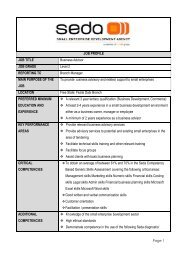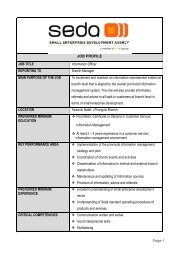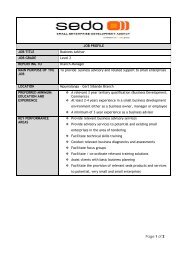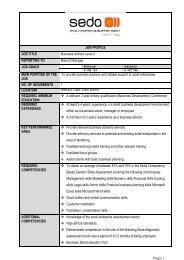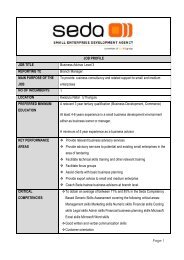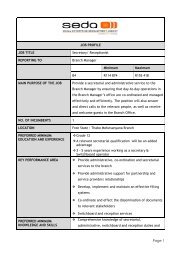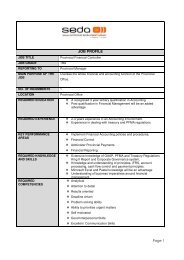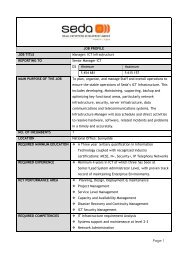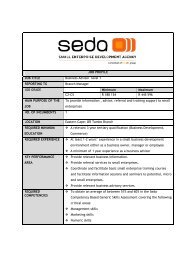Assessment of Cooperatives in the Poultry Industry - 2013.pdf - Seda
Assessment of Cooperatives in the Poultry Industry - 2013.pdf - Seda
Assessment of Cooperatives in the Poultry Industry - 2013.pdf - Seda
You also want an ePaper? Increase the reach of your titles
YUMPU automatically turns print PDFs into web optimized ePapers that Google loves.
Research Report: Address<strong>in</strong>g <strong>the</strong> Needs, Opportunities and Challenges <strong>of</strong> <strong>Cooperatives</strong><br />
and Collectively Owned Enterprises <strong>in</strong> <strong>the</strong> <strong>Poultry</strong> and Related Industries<br />
representative highlighted that egg production is an easier market for entry by new farmers.<br />
In order to fur<strong>the</strong>r understand why a particular bus<strong>in</strong>ess type is chosen, <strong>the</strong> reason for start<strong>in</strong>g a<br />
cooperative is <strong>in</strong>dicative. Many cooperatives <strong>in</strong>terviewed reported that <strong>the</strong>y formed <strong>the</strong>ir<br />
cooperative <strong>in</strong> order to create jobs to address unemployment. Half <strong>of</strong> <strong>the</strong> cooperatives <strong>in</strong>terviewed<br />
stated this as one <strong>of</strong> <strong>the</strong> reasons for start<strong>in</strong>g up <strong>the</strong>ir cooperative, amongst o<strong>the</strong>r reasons.<br />
<strong>Cooperatives</strong> were asked why <strong>the</strong>y had formed <strong>the</strong>ir bus<strong>in</strong>ess; out <strong>of</strong> all <strong>the</strong> responses, 41% started<br />
<strong>the</strong>ir bus<strong>in</strong>ess <strong>in</strong> order to create employment with 47% <strong>in</strong>dicat<strong>in</strong>g that <strong>the</strong>y had identified a gap <strong>in</strong><br />
<strong>the</strong> market. Thus, more cooperatives have been<br />
established due to a gap <strong>in</strong> <strong>the</strong> market. However, it<br />
should be noted that <strong>of</strong> <strong>the</strong> non-operational<br />
cooperatives, 100% were established due to a desire to<br />
create employment. This may demonstrate that<br />
cooperatives who start simply to create employment<br />
50% <strong>of</strong> cooperatives <strong>in</strong>terviewed<br />
reported that <strong>the</strong>y formed a<br />
cooperative <strong>in</strong> order to create jobs<br />
as a result <strong>of</strong> unemployment<br />
do not always assess <strong>the</strong> potential need for <strong>the</strong>ir bus<strong>in</strong>ess <strong>in</strong> <strong>the</strong> market. Additionally, if a<br />
cooperative is formed without market identification, <strong>the</strong> bus<strong>in</strong>ess may mirror what o<strong>the</strong>rs are<br />
already do<strong>in</strong>g <strong>in</strong> a market that is saturated. A SEDA representative confirmed that this ‘tomato<br />
syndrome’ has been seen amongst small bus<strong>in</strong>esses.<br />
O<strong>the</strong>r reasons cited by cooperatives for form<strong>in</strong>g <strong>the</strong>ir bus<strong>in</strong>ess <strong>in</strong>cluded government encouragement<br />
or enthusiasm as a result <strong>of</strong> mentorship by a family member or friend with experience <strong>in</strong> <strong>the</strong><br />
<strong>in</strong>dustry.<br />
Support for cooperatives is prom<strong>in</strong>ent dur<strong>in</strong>g <strong>the</strong> start-up phase <strong>of</strong> <strong>the</strong> bus<strong>in</strong>ess. A SEDA<br />
representative confirmed that many cooperatives request support where <strong>the</strong>y see an opportunity<br />
and would appreciate assistance <strong>in</strong> establish<strong>in</strong>g <strong>the</strong> bus<strong>in</strong>ess. Based on this, <strong>the</strong> challenges faced by<br />
cooperatives <strong>in</strong> this <strong>in</strong>itial phase are key <strong>in</strong> understand<strong>in</strong>g where support is most <strong>in</strong>strumental, as<br />
perceived by cooperatives. The forms <strong>of</strong> support that cooperatives believe <strong>the</strong>y require fur<strong>the</strong>r<br />
along <strong>in</strong> <strong>the</strong> bus<strong>in</strong>ess life cycle are discussed <strong>in</strong> Section 4.1.2.5 <strong>of</strong> this report under <strong>the</strong> head<strong>in</strong>g<br />
Support and Challenges.<br />
Table 4-1 below <strong>in</strong>dicates <strong>the</strong> challenges cooperatives reported fac<strong>in</strong>g at <strong>the</strong> start-up <strong>of</strong> <strong>the</strong>ir<br />
bus<strong>in</strong>ess. Participants <strong>in</strong>dicated all <strong>of</strong> <strong>the</strong> challenges faced at <strong>the</strong> start <strong>of</strong> <strong>the</strong>ir bus<strong>in</strong>ess and<br />
<strong>the</strong>refore <strong>the</strong> percentages below represent <strong>the</strong> number <strong>of</strong> responses for each category as a<br />
proportion <strong>of</strong> <strong>the</strong> total number <strong>of</strong> responses received.<br />
The Table (4-1) below illustrates that a lack <strong>of</strong> basic start up equipment was <strong>the</strong> greatest problem<br />
cooperatives experienced dur<strong>in</strong>g <strong>the</strong> start <strong>of</strong> <strong>the</strong>ir bus<strong>in</strong>ess. This is closely related to a lack <strong>of</strong><br />
f<strong>in</strong>ances, which was <strong>the</strong> second largest concern reported by cooperatives.<br />
41 | P a g e U r b a n - E c o n : D e v e l o p m e n t E c o n o m i s t s



